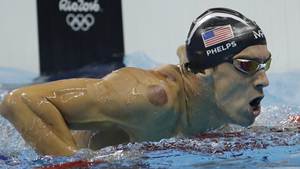
A number of Olympians – including the most decorated Olympic athlete of all time, Michael Phelps – have been photographed with large red circles on their skin.
What are they, and why is everyone suddenly going dotty over them?
The mark of an Olympic athlete, at least at Rio 2016, seems to be a scattering of perfectly round bruises. Swimmers and gymnasts, particularly from Team USA, are among those seen sporting the mysterious dots.
No, not paintballing misadventures or love bites – they are the result of a practice known as “cupping”; an ancient therapy where heated cups are placed on the skin.
So how is ‘cupping’ done?
The technique, which is a form of acupuncture, is done by lighting flammable liquid in a glass cup.
Once the flame goes out, the drop in temperature creates suction which sticks the cups to the body.
The suction pulls the skin away from the body and promotes blood flow – and leaves those red spots, which typically last for three or four days.
Why are some Olympians using it?
Athletes say they are using it to ease aches and pains, and to help with recovery from the physical toil of constant training and competing.
Practitioners claim cupping helps with a huge variety of ailments from muscle problems, pain relief, arthritis, insomnia, fertility issues, and cellulite.
Mr Long, who has practised cupping for 20 years, says the idea is to help the flow of energy – known as traditional Chinese medicine as “qi” – around the body, and rebalance its equilibrium – “ying and yang”.
The darker the mark left by the cup, he says, the poorer the blood circulation is in that part of the body.
It’s not only athletes who use cupping. The practice has long proved popular among A-listers in search of the next best therapy.
In 2004, Gwyneth Paltrow appeared at a film premiere revealing the signs of cupping on her back.
Cupping has also become an increasingly available and popular treatment in beauty parlours and spas, as well as traditional Chinese medicine shops where it is commonly on offer.
How did it start?
Cupping originated in China some 3,000 years ago, Mr Long says, but also became popular in Egypt, the Middle East and around the globe.
Before glass cups, cups made of bamboo were used to the same effect. The technique is known in Mandarin Chinese as “huo guan”, which means “fire cupping”, and is popular in China with older generations, he says.
There is also a technique known as “wet cupping”, which is done in both China and some parts of the Muslim world where it is known as “hijama”.
It involves making a small cut in the skin before the cup is placed. The suction draws out a small quantity of blood.
Mr Long says many people in Western countries find this “difficult to accept”, but explains that it is seen in Chinese medicine as a type of detox and is very popular.
Source :- BBC

Leave a Reply